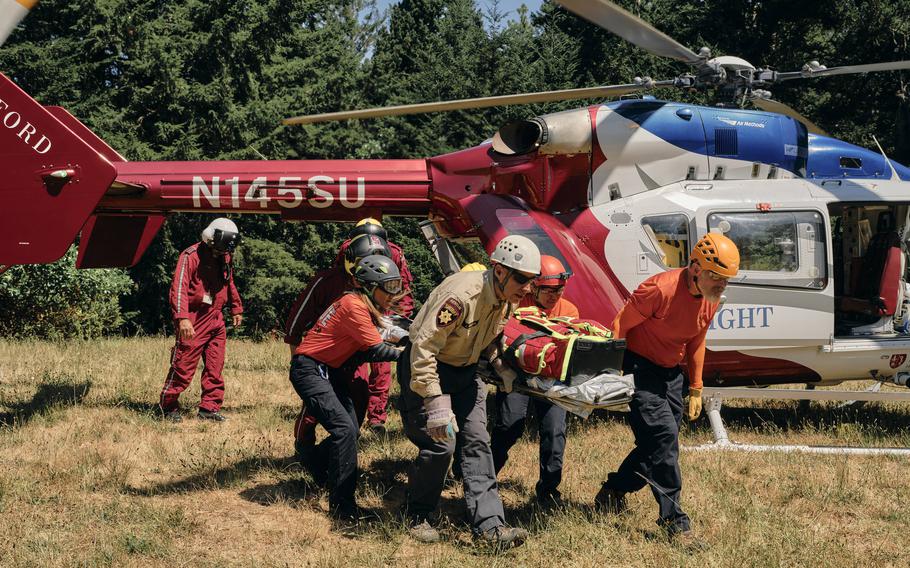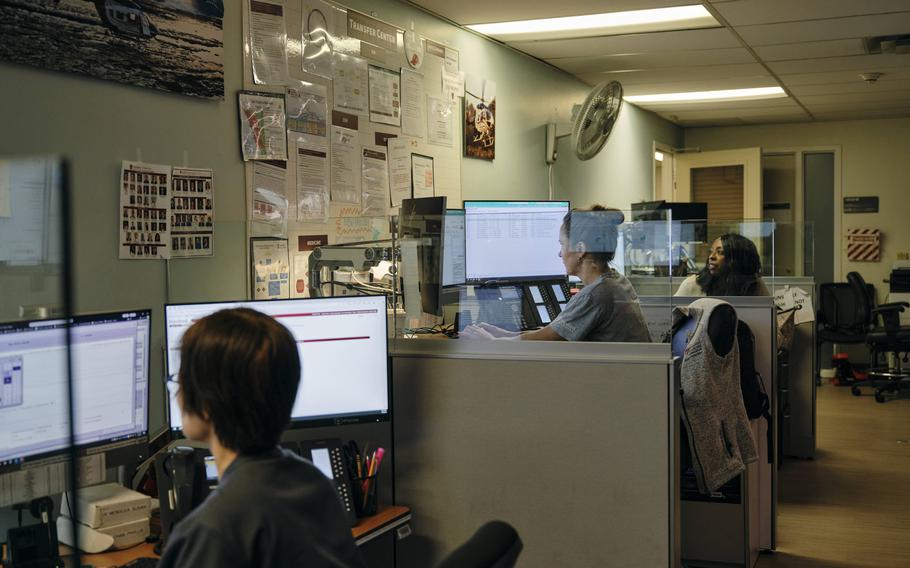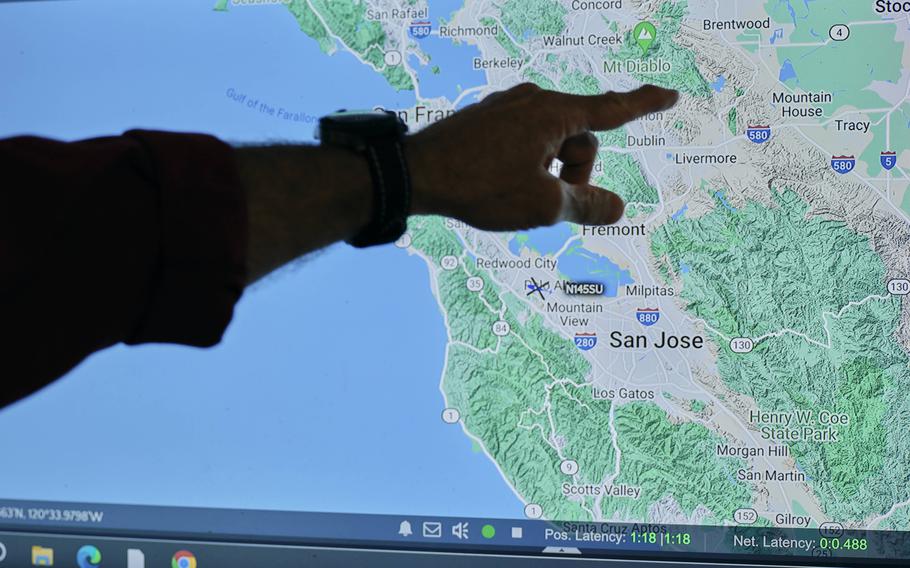
Members of Stanford Life Flight conduct a multiagency landing zone orientation in Kings Mountain, Calif., on Saturday. (Philip Cheung/The Washington Post)
STANFORD, Calif. — The call came at 2 p.m. Sunday: A driver suffered a brain injury in a traffic accident and needed to be flown to a different hospital as soon as possible.
Lead helicopter pilot Douglas Evans noted the 116.6-degree temperature in Redding, Calif., where he would need to land. The tarmac was probably even hotter. In 27 years of operating medical helicopters around California, Evans had never had to cancel a flight because of excessive heat — until now.
It was too hot to fly. Evans and other emergency responder pilots are used to factoring California’s wind, fog and fire smoke into their flight decisions. But extreme heat, like the intense wave blanketing the West right now, is affecting the way rescue helicopters can carry out their missions.
High temperatures, which are increasing due to human-caused climate change, are altering operations in broad swaths of the state. REACH Air Medical Services, which operates 30 helicopter bases across California, declined at least two rescue calls over the weekend because of excessive heat, said Vicky Spediacci, the company’s chief operating officer. “This is pretty rare. There can be pockets but this was more widespread,” she said.
The company sometimes reroutes in hot weather to land at an airport — where there are fewer obstacles — instead of on the scene. Landing in a confined area can require more engine power, which is harder in high temperatures, said Spediacci, who was a pilot for 40 years.
The heat is hampering efforts to transport patients and conduct rescues in the region’s national parks, places that can rely on choppers amid the vast wilderness. When hikers get lost or become stranded on remote trails, helicopters are sometimes sent to locate and pull them out.
National parks including Joshua Tree and Death Valley warn visitors that a helicopter may not be able to reach ambitious hikers in the heat, park rangers said. When temperatures pass 122 degrees — which has already happened this year in parts of California including Death Valley — medical helicopters often cannot fly.
A helicopter was unable to fly to a rescue in Death Valley this weekend because of the heat, officials said. Six motorcyclists were traveling together through the park. One person died of heat exposure, another was “treated for severe heat illness” and transported to a hospital, and four were treated on-site and released, officials said.
“Due to the high temperatures, emergency medical flight helicopters were unable to respond, as they generally cannot fly safely over 120 degrees,” a news release said, noting that it was 128 degrees that day.
Death Valley Park Ranger Nichole Andler said in an interview Tuesday that the person who died was declared dead at the scene. Rangers called a helicopter for the severely injured person, but it declined to come because it was too hot out, she said. The injured person was transported by ambulance to a hospital in Pahrump, Nev., and later Las Vegas, she said. Their condition is unknown.
Andler told The Washington Post earlier this month that the park gets one to three requests a month for air ambulances during the summer to bring people to medical care. Sometimes patients are driven by ambulance to higher, cooler altitudes, where a helicopter can more safely take off and land.
“As the temperatures get more frequently higher, it becomes harder to help out,” Andler said.
In Joshua Tree, the national park in Southern California known for its dramatic desert landscapes, helicopter rescues can happen three to five times a year, said Anna Marini, a park ranger there. The park saw temperatures peaking above 110 degrees all weekend.
A few weeks ago, Marini said the park called in a chopper for a hiker who had heat exhaustion off trail in the middle of the afternoon. The terrain wasn’t flat or easy to get to by vehicle, and it was cool enough for the person to be rescued by helicopter. But when it’s hotter, such rescues might not be possible, she said.
“Intense heat creates a lot more stress on the helicopters,” Marini noted. “That could affect our operations.”
When it is hot out, the air is thin, meaning choppers’ blades have less air to grab onto. That affects their ability to lift off and navigate. The systems onboard can overheat and stop working. Pilots have to make adjustments to weight, equipment and route planning — or they may have to decline to go altogether.
When Evans — who works for Stanford Life Flight, Stanford University Hospital’s medical helicopter response program — checked conditions on Sunday, he knew the chopper’s engine, radio and computers ran the risk of malfunctioning.

Stanford Health Care staff coordinate patient transfers on Saturday. (Philip Cheung/The Washington Post)

Michael Baulch, program manager of Stanford Life Flight, points to areas of helicopter service coverage across California. (Philip Cheung/The Washington Post)
“It’s something that we’re going to have to be more aware of now,” Evans said. “I see that things are warming up and I expect it just to get worse,” he said.
At around 5:30 p.m., a team in Redding that had also initially turned down the call due to heat deemed it cool enough to transport the patient, said Michael Baulch, the program manager at Stanford Life Flight. They arrived at Stanford by approximately 8 p.m., but had lost critical hours waiting for cooler weather, he said.
By Tuesday, Baulch said, the patient was in stable condition.
The Airbus EC-145 that Stanford flies is prepped for many missions. It can move newborn babies from one facility to another; it can fly patients to more advanced operating rooms across the state while their chests are open in the middle of heart surgery; it can breeze past rush-hour traffic, arriving on the scene of a car accident long before an ambulance.
“When it’s hot like this, we’re not able to lift as much weight,” Baulch said. “We either have to leave people or equipment behind.” The 40-year-old unit, which operates as far south as Santa Barbara and as far east as Reno, Nev., does about 480 medical transports each year. About 30 percent of those are responses to 911 emergency calls.
Deep in the basement of the hospital in Stanford, a control room of about six employees and at least 20 screens is abuzz around-the-clock, fielding calls and requests for medical air support. When a call comes in, control radios the pilot and asks if the weather is good to fly.
“We won’t tell the pilot the details of the case to avoid any biases,” Baulch said.
If the flight is approved, the nurses and pilot on duty zip up their thick, fire-resistant fly suits and board the chopper. On a flight over the Santa Cruz Mountains, the Stanford team was feeling the heat. The temperature was in the 90s, but the helicopter had sat in the sun while the crew trained local firefighters and park rangers on how to assist the crew in a rescue. The engine was about as hot as it could safely get, said Evans, the pilot.
The unbreathable maroon suits covered the crew’s legs and arms. Sun blared through the cockpit window on a cloudless Saturday, while air conditioning vents puffed out weak streams of air.
The flight was just five minutes long, but upon landing the staff peeled off their layers and reached for chilled water bottles and frozen treats they keep on base. Trips for them can be as long as two hours.
“You basically just sit there and roast,” said Kent Cramer, one of the flight nurses, as he sucked on a lime-green ice pop.
Kevin So, another nurse, wheeled out a bulky turquoise contraption that the crew affectionately calls “the snork.” Attached to the box is a hose that blows cold air into the cockpit while it sits on the tarmac.
Sometimes Evans will fly to higher altitudes to cool down the helicopter, but often ascending means less oxygen for a patient already in distress.
Even under the 122-degree limit, high temperatures affect the team’s operations. “Above 104, we can only operate on the ground for 15 minutes,” Evans said.
Evans knew early in life he wanted to be a pilot. He started off flying small planes but says he realized it is more fun being able to move sideways and backward, to hover and fly among the trees. That he flies to save lives only makes the job more rewarding.
His favorite missions are the ones that involve obstacles: landing on bridges or beaches, navigating the chopper in the middle of a city.
But heat was an obstacle he didn’t see coming, one he anticipates will make his job harder if he has to turn down more flights.
“It is the most difficult part of the job,” he said, “saying no.”